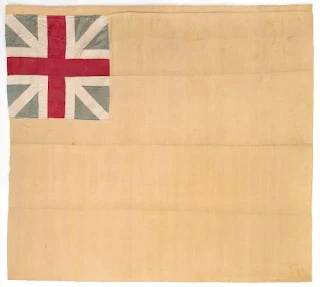This flag was donated to the Monmouth County Historical Association by Mrs. Marguerite Potter Bixler, the great- great- granddaughter of Capt. William Wilson of the First Pennsylvania Regiment. According to family tradition it had been captured by Wilson at the Battle of Monmouth on 28 June 1778. It was supposedly the flag of Lt. Colonel Henry Monckton, who commanded the 2nd Grenadier Battalio and was killed leading his command in the battle. Wilson also captured a sword believed to have belong to Monckton. The first recorded mention of the flag is an 1874 account in the American Historical Review. The color was seen at the Bellefonte, PA, home of Capt. William Wilson Potter, grandson of Capt. Wilson, and that it was stained and torn along its staff edge.
The flag is described in the museums catalog. "A rectangular flag consisting of a yellow silk ground, pieced from four lengths of fabric sewn horizontally along selvedge edges. In the upper left corner, a British union canton sewn to the yellow silk, offset three inches from the top edge, pieced together of plain weave white and blue silk, with red silk brocade central cross. A pole sleeve on the left edge of the flag has been folded underneath."
Certain features of the flag indicate it is an American rather than British colour. Probably a division color from the 1st Pennsylvania Regiment. The presence of the British union canton, often seen on American colors in the early years of the war, could have led to the tradition that the color was British. American divisional colors were generally plain but a British color would have had both a symbol and a unit designation. Also, a British color would not have had an inset canton. But a number of surviving American colors do. The red and white crosses and blue field of the canton are formed of red silk (Damas), blue silk (watered or moire effect), and white silk. The materials used, the proportions of the crosses, and the very wide white edging to the Cross of St. George are not typical for British flags. The materials and construction techniques used suggest that it was quite probably "home-made" of fabrics available to the seamstress


Your conclusion is surely more probable than the claim this is a British colour Mark, particularly one belonging to a guards officer. A guards unit would never have a yellow fielded colour for a start...maybe the sword is genuine? It's still a great family heirloom whatever it's real provenance....unless it was run up in 1860 of course!
ReplyDeleteGreat info Mark. But gotta agree, I can't see how it could be a British flag, especially for the Guards?
ReplyDeleteIt does indeed look like an American color. Thanks for this.
ReplyDelete